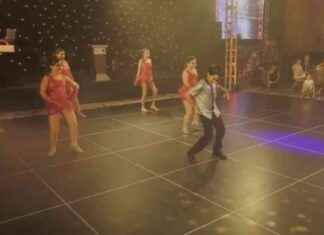The acclaimed Portuguese filmmaker Pedro Costa, the Brazilian journalist, politician and cartoonist Jean Wyllys, and the American experimental artist Art Larson join their creative forces to show all their art at La Virreina Center de la Imatge starting today through three exhibitions that will illuminate the institution located on La Rambla during a good season.
Articulated from ten works, five of them made expressly for La Virreina, Pedro Costa’s Song revolves around the face, the voice and the song as “signs of what is most particular to each person, but also as a response to the combined pressure of History with individual history. It is a continuous experience where all the themes of his work, which takes place in a very closed darkness, are present together with the modulation of the song”, explains the curator Javier Codesal about an installation “which is very beautiful” and which reflects “that restlessness of Costa’s work that never ends”.
With twenty productions behind him as a director, such as Casa de Lava, Caballo Dinero or Vitalina Varela, a drama about immigration with which he won the Golden Leopard at the Locarno Festival in 2019, Costa believes that the visitor who does not know his work will observe the sample “with fear and trembling”. The exhibition, sheltered under a penetrating darkness, that which the filmmaker wanted to “darken even more”, establishes a constant dialogue between fragments of his films.
First of all, a scene of the work of making music by the French actress and singer Jeanne Balibar in the film Ne change rien. “She works hard to get the rhythm but something is holding her back. It seemed extraordinary to us as the start of the exhibition”, adds Codesal. The songs are filtered from one room to another with the idea that the characters touch and look at each other.
The personality of Ventura’s face, the protagonist of Caballo Dinero, breaks through with force humming Alto cutelo, a typical piece from the Carnation Revolution that speaks of independence and freedom. “It is the life of the Cape Verdean immigrant who has come to Lisbon and lives in very difficult conditions,” says the commissioner.
There are three pieces entitled Our voices will not sing anymore and they differ only by the name of the character who sings: one is Irondina, Adelaide and Clotilde, constant names in Costa’s filmography. “It points out the particularity of each body, of each voice. Although they sing the same starting text, each version is different. The origin comes from The Three Sisters, by Chekhov. A text written in the 19th century that speaks of the decline of the Russian peasant aristocracy is suddenly used by three Cape Verdean immigrants to talk about their situation in the present”.
Another installation presents us with images of Casa de Lava, where we can appreciate the fixation on the face, the position of the mouth in relation to the eyes, and where the song adds another dimension through small loop sequences, like a kind of mobile portrait. The idea is that “it works in relative silence, almost listening” and it is a place to walk.
The exhibition is completed with the publication of the essay Canción de Pedro Costa, by Javier Codesal, and a seminar entitled To avoid suicide. On the work of Pedro Costa, which will take place from February 13 to 17, 2023. Coinciding with the exhibition, which will be open to the public until April 23, the Filmoteca will dedicate a complete retrospective and carte blanche to him between January and February 7.
Also until Sant Jordi, La sombra del dominguero will be on, dedicated to Art Larson, which questions the relationship between the work we see and the artist who created it. “One of the main lines of La Virreina is the investigation of artistic heterodoxy and Larson is part of the tradition of rupture”, says Valentín Roma, curator of the exhibition. Nonconformity, rebellion and recklessness are characteristics of the American’s work. “His priority is to experiment, not so much to diagnose.”
Thus, the exhibition is a selection that brings together 20 years of work in which experimental video in the style of Chris Marker, personal calendars…”Art is a pioneer of that underground of the sixties and seventies. He has that exercise of the absolute freedom to jump from the most prosaic to the most divine, and the installation is a small cocktail of all these practices”.
Roma is also the curator of Desexilio, around the work of Wyllys, which will be in La Virreina until January 15. “We have never made an exhibition as timely and necessary as that of Jean”, who is part of a generation of intellectuals threatened by the extreme right.
Desexilio brings together almost a hundred drawings, compositions and collages made by Wyllys (Alagoinhas, Brazil, 1974) during exile, which make up a kind of log with which the artist narrates his subjectivity, his memories, his mythologies and his ways of taking the word and politicize existence. He mixes genres and techniques, from portraits of characters from popular culture to dissident allegories. Paper bags, newspapers, cardboard or pads serve as the basis for his “visceral” creations.
After serving as a federal deputy with the Partido Socialismo e Liberdade (PSOL) between 2010 and 2018, Wyllys went into exile – to this day – for suffering death threats and homophobic and racist persecution.
Rome frames his work in the forced exile that affected other intellectuals and artists such as Marcia Tiburi, Wagner Schwartz and Débora Diniz, harassed by Bolsonaroism, which would find its most terrible expression with the murder in 2018 of Marielle Franco, councilor of Rio de Janeiro and one of the most prominent voices in the demands for the rights of black women in Brazil.
Born into an environment of extreme poverty, Wyllys wanted to express himself as a child through the visual arts. He is currently pursuing a Ph.D. on the creation and propagation of ‘Fake news’ as government technology. “Beauty serves to disarm” – emphasizes the artist about the exhibition – “which does not revolve around Brazil, but around all the threatened democracies”.








